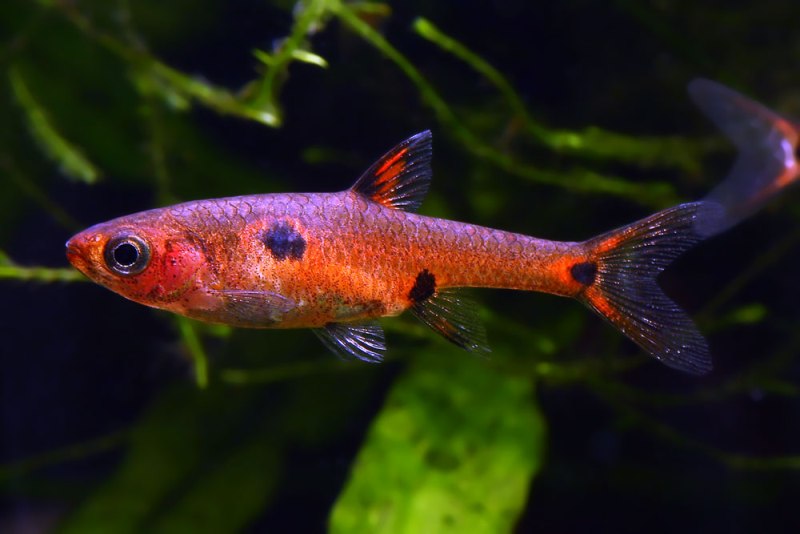The Dwarf Rasbora (R. macula) is also referred to by tropical fish keeping enthusiasts as the Dwarf Spotted Rasbora, Dwarf, Pygmy Rasbora, or the Spotted Rasbora.
Dwarf Rasboras are widely distributed in southeast Asia and are found in southern Thailand (from Phunphin in Surathani Province south), Peninsular Malaysia, Singapore, Indonesia (Sumatra and unconfirmed records from Kalimantan).
The Dwarf Rasbora is vivid red with three or more dark black spots on the body behind the gill cover and adjoining the anal and caudal fin. The males are more vividly colored than the females, and the females have an extra dark spot above the anal fin on both sides of their bodies.
The Dwarf Rasbora is a bottom dwelling species that inhabits the thickly vegetated slow flowing black water forest streams and freshwater swamps in their area of distribution. It is a a micropredator that feeds on worms, crustaceans, small insects, and other zooplankton. The waters where spawning occurs is usually shallow and thickly vegetated, with a maximum depth of 6 inches.
Dwarf Rasboras are an active, peaceful, sociable fish that prefer living in loose shoals with others of their own kind.
Because of their diminutive size (0.5″ to 1.0″) they should be housed in densely planted tanks with driftwood and catappa leaves
on a sandy or fine aggregate bottom. They do best in very acidic (pH 6.2 to 6.4) tannin stained water under low lighting conditions. Floating plants should be added to provide the shady conditions they thrive in and to bring out their colors.
This is one species that benefits from the addition of dried leaf litter (Catappa leaves) to the tank. As decomposition of the leaves occur, microbe colonies will begin to flourish. These colonies of tiny creatures provide a valuable food source for the Dwarf Rasboras, especially the fry. In addition, the tannins and chemicals that are released into the water as the leaves decay are beneficial to all blackwater species.
Using almond leaves for blackwater aquariums, (Catappa leaves) is an economical way to provide Dwarf Rasboras and other delicate species the tannin stained water they require in an aquarium environment.
The leaves should be left in the tank to break down and can be replenished every couple of weeks to maintain the desired water color.
Because of their small size, care should be exercised when choosing tank companions for these small Cyprinids. They do well with Chocolate Gouramis (Sphaerichthys), Licorice Gouramis (Parosphromenus ), small Bettas, and freshwater shrimp such as Caridina or Neocaridina (Cherry Shrimp, Snowball Shrimp, Blue Pearl Shrimp).
Dwarf Rasboras are among the easiest of the species to spawn. They need only a small densely planted tank with soft, acidic water, the addition of a catappa leaf or two, and low lighting for spawning to commence. After the eggs are deposited, remove the pair to protect the spawn from being eaten.
Being carnivores, Dwarf Rasboras will accept most small foods. In the absence of a biotope environment, they do well on a diet of crushed flakes, small micro-pellets, microworms, brine shrimp, and daphnia.
Dwarf Rasboras are rarely available for purchase but are less than 1″ in length when available.
Minimum Tank Size: 5 gallons
Care Level: Moderate
Temperament: Peaceful
Lighting: Subdued
Water Conditions: 75.2-78.8°F, 5-12 °d, pH 5.0-6.5
Max. Size: 0.5″ to 1″
Color Form: White/Red
Diet: Carnivore
Compatibility: Suitable for biotope
Origin: Southeast Asia, Indonesia
Family: Cyprinidae
Life Span: 2 to 5 years
Aquarist Experience Level: Intermediate



The tank isn’t setup correctly.
You need less intense lighting, more tannins in the water, and much less flow. That’s why they aren’t as red as they should be.